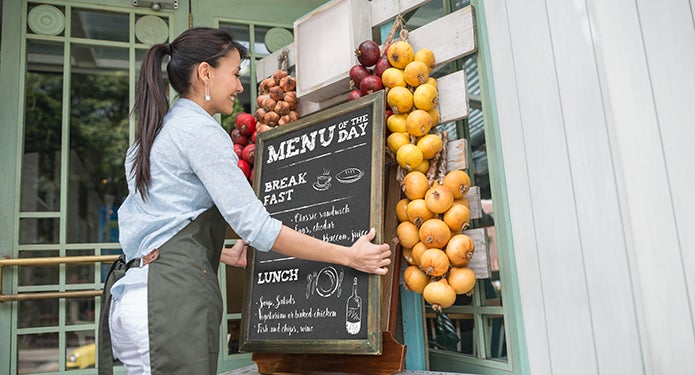Keep guests coming back for more and offer them an expanded experience by nailing Limited Time Offers.
Limited Time Offers (LTOs) have long been a consistent driver of sales and profitability for chain restaurants. The concept is simple—offer unique and/or seasonal ingredients over a restricted period of time. National and regional chains have used LTOs very skillfully, supplementing their regular menus with on-trend ingredients, flavours and dishes that help them stay relevant in competitive environments.
Chains also are adept at capitalizing on another LTO benefit, this one on the cost side. Operators can maximize profitability by timing the market and buying products at their most favourable prices—and then using the products to create LTOs priced in line with or higher than regular menu prices.
Independent restaurants have not generally employed LTOs to the same degree or with the same sophistication as chains, largely because of concerns about product availability, price and consistency. It’s time to put those apprehensions aside. The trend toward smaller core menus as a means to control costs practically requires operators to use LTOs as they strive to keep the guest experience fresh. Luckily, new tools and resources are available to help independents implement LTOs more easily and effectively.
While chains have mastered the art of the LTO, the truth is that independents are even better positioned to utilize them. Independents have the ability to execute more nimbly, manage their brand more effectively and create more relevant connections with local audiences. Offering LTOs also reinforces customer perceptions that menu innovation comes from the independent sector of the restaurant industry.
Nimble execution
The ability of independents to quickly field any form of LTO is an undeniable competitive advantage. The time it takes for an independent to plan and execute an LTO is much shorter because there are fewer people involved at each step of the process:
- Menu ideation
- Testing
- Staff Training for both front and back of house
Brand-driven dishes
LTOs must support your brand. It can be tricky to balance the need to deliver the fresh experience guests expect with the necessity of reinforcing “who you are.” But it’s essential—you don’t want to confuse guests (who may visit twice a month on average) with mixed messages. Think about how you can extend your brand through an LTO. For example, if your brand position is, “the best dry-rub barbecue house in the city,” you might consider adding dry rub to different steak and chicken cuts—purchased at favourable commodity prices—as LTO options.
Locally relevant communication
Historically, LTOs have been promoted through simple table tents and/or server communication. Today, your online and social media presence allow you to share more timely and customized messaging to guests. The guest perception of independents as “local” allows you to connect more meaningfully with customers, especially if you link LTOs to local events such as:
- Local sporting events
- Festivals
- Key local holidays
- City services
- Community programs
The ultimate success of an LTO will always rest on quality food and execution. But emphasizing a community connection in LTO marketing will help you maximize value and impact.
Menu ideation
Increasing access to diverse foods and a desire for more food exploration continues to raise guest expectations for new and unique dining experiences. The LTO can be employed to deliver experiences that create a true point of differentiation in the market—and to test the value of differentiations before they make it to the full menu.
The key is to remain focused on your brand but stretch your current guest experience and attract new guests. Consider subtle extensions of the brand that may elevate cheque average or appeal to different audiences. Getting back to the above example of the best dry-rub barbecue in town—testing boil-in-the-bag/low-country seafood with the same dry rub ingredients could enhance your cheque average and expand your customer base.
The finite shelf life of an LTO enables you to test new ideas with manageable risk. Even if it doesn’t work as well as hoped, you haven’t invested anywhere near what you would in adding an item to your regular menu.
Get started on spring holidays
You should plan LTOs on a quarterly basis—so now is the time to plan and test them for Easter, Mother’s Day and other spring holidays. Here are some simple steps you can take to maximize success:
- Start with your brand as your guiding principle
- Identify your goal (e.g., cheque average, new clientele, improved profitability, brand extension)
- Tap into your Sales Representative to understand and capitalize on commodity market conditions
- Take advantage of resources and insights from your Sales Representative to explore new menu ideas and trends
- Seek out industry-tested recipes to ensure they can be executed in your commercial kitchen
- Test recipes in your kitchen with your back-of-house staff
- Communicate to the public no less than 30 days prior to LTO availability, employing social media and tying them to local events as much as possible
- Run your LTO no longer than six weeks (a good rule of thumb for all LTOs)
Give customers what they want
LTOs are essential to meeting guests’ desire for new experiences. You can be sure that guests will seek these experiences elsewhere if you don’t offer them. Remember, independents are better able to utilize LTOs than chains, so you should not hesitate to employ this competitive advantage.
The upcoming spring holidays are prime occasions to reach guests who may not normally visit your establishment. Give them something to talk about, anticipate and savour.
More for your LTOs
Ask your Sales Representative about Created to Inspire, a publication showcasing new, on-trend products you can use to be first to market with an LTO.










